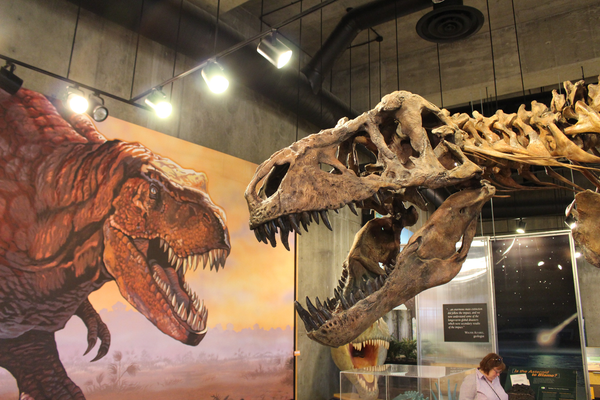This article was published in Scientific American’s former blog network and reflects the views of the author, not necessarily those of Scientific American
“Scotty” isn’t exactly a new to the throne. The skeleton of this impressive Tyrannosaurus rex, found in Saskatchewan and the centerpiece of the province’s T. rex Discovery Centre, has been known to dinosaur aficionados since 1991. But the tyrant king has been stomping around the science news cycle this week as the oldest, and largest, T. rex yet known.
But has Scotty truly earned the crown? Is that even the right question to ask?
Scotty – known to researchers as RSM P2523.8 – is pretty exceptional as far as T. rex goes. That’s because the skeleton includes about 65% of the expected parts. And those fossils are at the center of a new study by paleontologists W. Scott Persons, Philip Currie, and Gregory Erickson that heralds this dinosaur as “An older and exceptionally large adult specimen of Tyrannosaurus rex.”
On supporting science journalism
If you're enjoying this article, consider supporting our award-winning journalism by subscribing. By purchasing a subscription you are helping to ensure the future of impactful stories about the discoveries and ideas shaping our world today.
Dinosaurs are not just for display. In-depth studies like this offer basic information about individual animals that can help provide a clearer image of what a vanished species was like. This is especially critical when sample sizes are small. There are about 50 known partial T. rex skeletons from the dinosaur’s two million year reign. That’s pretty good for dinosaur standards, but imagine how little we’d understand if we only had such a sample size for animals like jaguars or spotted hyenas. Every piece is important.
At about 28 years of age, Scotty was undoubtedly old for a T. rex. That’s about the same age-at-death for the famous, nearly-complete “Sue.” But it’s the matter of size that has shone a spotlight on Scotty.
Scotty’s size estimate comes out to about 42.6 feet, just stretching past Sue. And the new weight estimate is almost 900 pounds heavier than that the researchers calculated for Sue. There’s no doubt that Scotty was a huge dinosaur that represents the ultimate in the evolution of non-avian predatory dinosaurs (partly because there weren’t any more after an asteroid dropped the curtain on the Cretaceous soon after Scotty’s time). But in the classic “my dinosaur is bigger than yours” contest, Scotty might not be the apex, after all.
There’s the basic fact that Scotty isn’t as complete as Sue – about 65% to about 90% in Sue’s case. That matters. A few inches here or there on this or that missing vertebra can add up, especially when the two individual T. rex are already so close. Bulk gets tricky, too. Paleontologist John Hutchinson has pointed out that previous mass estimates for Scotty have come out as comparable to Sue and are within the expected margin of error for these sorts of approximations. The difference between these two dinosaurs was likely a matter of ounces and inches.
That comes with understanding dinosaurs as animals, not kaiju-like monsters. It’s also why the constant fascination with the biggest dinosaurs can be so frustrating. What are we even talking about when we try to pinpoint the biggest dinosaurs? Length? Weight? Both?
Given all sorts of variations, it’d be possible for two T. rex to have exactly the same length but have different weights – or have different weights at varying lengths – in which case awarding a superlative title becomes subjective. Communicating paleontology and its findings often comes down to this kind of rough typology, which can blind us to the fact that dinosaurs were just like animals alive today. No two were exactly alike, and one skeleton can’t simply be swapped out for another on the assumption that proportions and dimensions are shared.
And this raises questions for science journalists, too. Given the shifting media landscape and the competition science constantly faces with all other news, “T. rex found 28 years ago is about as big as other T. rex” isn’t much of a story. Of course Scotty’s claim to the Largest Known title is going to be the headline. But this means healthy doubt and skepticism get buried, or not considered at all, especially in the shortform “inverted pyramid” news model in which a conclusion is shouted out first and details are driven towards the bottom. Clickbait is the rule in a media ecosystem where everyone is struggling for attention and ad money, and while it may seem frivolous in the dinosaurian realm it’s worth keeping in mind how the sausage gets made when science news turns to psychology and health.
Scotty truly is a spectacular dinosaur. And, by tyrannosaur standards, making it to 28 was no small feat. The overall picture of dinosaurian life is incredibly brutal. Most didn’t survive their first year. Exceptional dinosaur growth rates were a survival strategy, and, given that T. rex had no compunction about consuming its own kind, likely true for the tyrant king, too. Scotty also suffered an array of injuries, which seems to be standard for large carnivorous dinosaurs. Biggest or not, Scotty set an impressive record among T. rex. Hail to the king.
